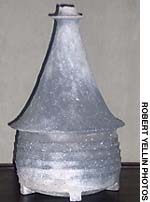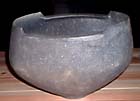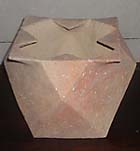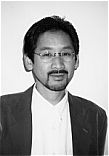|

Click here for
index to all
Yellin stories for
The Japan Times
LEARN MORE
ABOUT MIHARA
Bio
Interview
with Mihara Ken
Photo Tour
of His Work
Reshaping Japan
JPotters Bio

Yellin's gallery
sells pieces from
the kilns of Japan's
finest potters |
|
Potter digs in to unearth real "clay flavor"
By ROBERT YELLIN
for The Japan Times (Aug. 14, 2002)
The great Mashiko potter Shoji Hamada once wrote that, "the thing to remember is that the simplest clay is the best. Clay itself is already the most complex of mixtures because it is alive, a living thing." When it comes to shaping that "living thing," too many modern potters feel the need to stamp their personalities all over the clay and basically just "kill" it -- an artist's ego-trip so to speak.
|

|
|
Recent works by Mihara Ken include an unglazed dome (above); a large bowl (below); and a geometric form (bottom).
|
|
|

|
|

|
|

Mihara Ken
|
|
The Japanese have many terms to describe clay, my favorite being tsuchi aji or "clay flavor."
A good stoneware pot should always have fine tsuchi aji, even if it can be appreciated only on the base in the case of a glazed pot. How does a potter fulfil the desire to bring out the beauty of the clay without neglecting the desire to make an artistic statement? In short, the answer is to "listen" to the clay, to allow it to dictate how it should be fired and what form it wishes to attain.
Sounds like a realm for Zen monks or poets, but these days Shimane-based potter Ken Mihara is doing just what the clay asks -- and the stunning results are on display in Mishima, Shizuoka Prefecture, at the E-Y Net gallery until Sept. 18, 2002.
Shimane-based Mihara could be considered a clay poet and this poetic sense enables him to follow his intuition. As he said in a recent interview, "I consider it my job to help the clay express its beauty. Clay leads, and my hands follow. I do not know what shape my work is going to end up, even while I am making it."
He forms all his works using clay coils, in a method called himo-zukuri. This allows the pieces to be born out of a slow dialogue between the potter and the clay, unlike a rokuro (wheel) where a piece can be whipped up in a matter of seconds. In the current exhibition there are about 60 works on display and not one has the same form; bulbous, edgy, geometrical, slender or curvy describe the variety. The thing that unites the works, though, is the uniformity we find in the clay's color. Mihara digs his clay from his neighborhood, and it has a high-iron content that fires to a smoky bluish-gray hue; all the works follow that color line. The tsuchi-aji is fine, yet subtle, and does not compete with Mihara's truly original forms.
Many people ask Mihara what style of pottery he works in. He usually chuckles as he replies, "Oh, it's Mihara-yaki."
There really is no grand tradition that he's working in, besides his own -- yet for a term to describe his work, he's chosen sekki. Sekki is a style of yakishime (high-fired unglazed stoneware) that was used in, and died out in the late Meiji Period. Mihara feels that since his work is yakishime and unlike any other around, why not revive a term long forgotten to describe it. And so all his works are called sekki.
Mihara is interested in conveying subtle emotions in his sekki forms that transcend boundaries and speak of a universal and timeless beauty. His work recalls the softness of Yayoi-period low-fired works and also 6th-century high-fired Sueki.
There is also something mystical in Mihara's works that moves the spirit into a quiet inward world. His work is not art for art's sake, but more art for the sake of spiritual awakening -- art to refresh and stimulate the senses -- a visual haiku. So much of any art nowadays is merely shock value that makes a splash in some shallow pool and disappears without a trace. Yet, is not the real value of art to uplift the human consciousness to a plane that is close to a godlike realm?
In these times it's up to art, not religion, to give a person a feeling of sacredness in the everyday (although the two can merge at times). Viewing Mihara's work imparts such a feeling. One visitor to a Tokyo exhibition told me, "I was stunned by the simplicity and purity of his work and can understand his stature. You see his work and realize that he's in another sphere from so many artists."
It's rare to find a potter like Mihara who truly understands tradition. It is not the mere imitation of what has gone before. Instead, tradition is the bringing into the present (while using age-old ways if possible) of functional beauty -- a beauty that speaks of man living in harmony with nature in a context that matches the mood of the times. Mihara does all that with his cosmopolitan sculptural and functional vessels. His works speak of the beauty of clay and form and would would look equally at home in a temple or a high-rise Tokyo mansion
Shimane-based potter Ken Mihara
Others have also taken notice of Mihara's world, and he was awarded the Grand Prix in Tanabe Museum's prestigious "Modern Tea Form Exhibition" in 2001. He's also won awards at the Asahi Ceramic exhibition, the Tankou Biennale and the Japan Ceramic exhibition.
Yet it's not the awards that captured my attention and made me admire Mihara's work; it was the sheer beauty of the man's spirit coming through in his creations.
I find that, in a way, I'm looking into myself when I stand before a Mihara work -- I'm in tune with the same emotions that he must have felt when creating the work. I'm in tune with the ageless Muses that guide all art that speaks to a common humanity. I'm in tune with a presence that borders on the divine. Such is the power that only rarely appears these days in clay. Such is the gift that Mihara creates when he listens to clay -- and to his beautiful spirit.
The Japan Times: Aug. 14, 2002
(C) All rights reserved
For more on this artist, please visit:
Photo tour of Mihara's pottery
Interview with Mihara Ken
Reshaping Japan's Ceramic Landscape
JPotters Bio
|